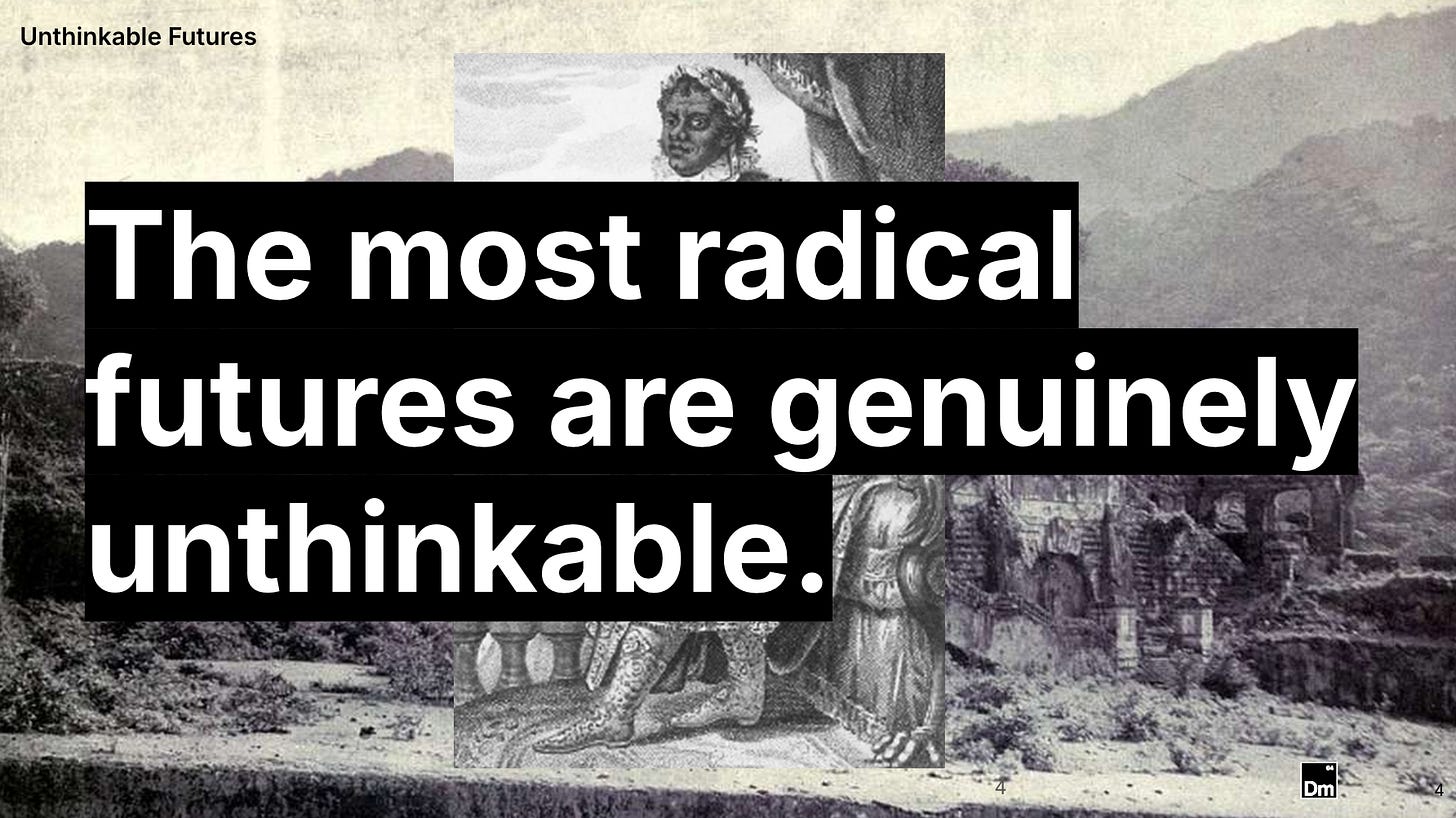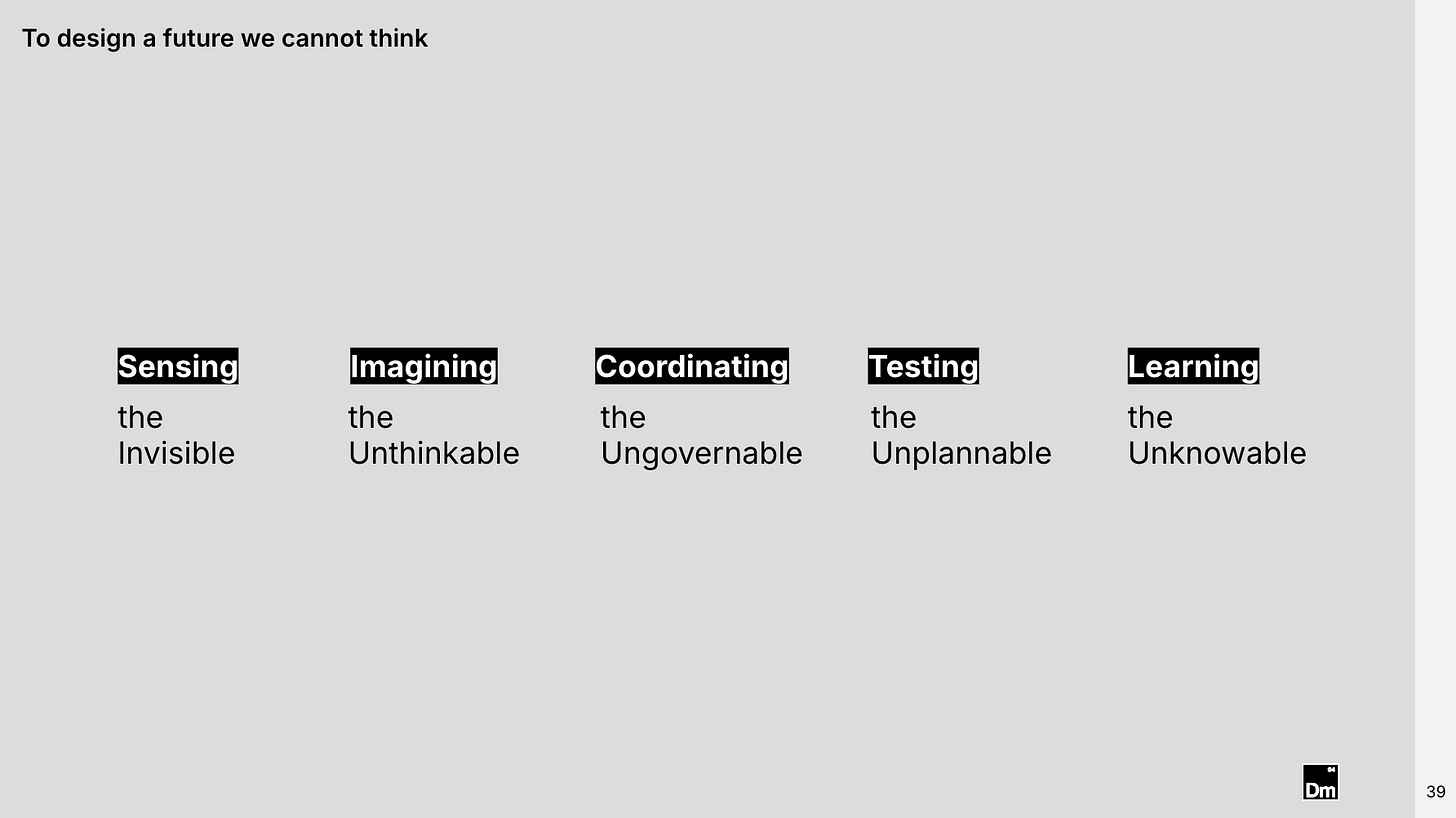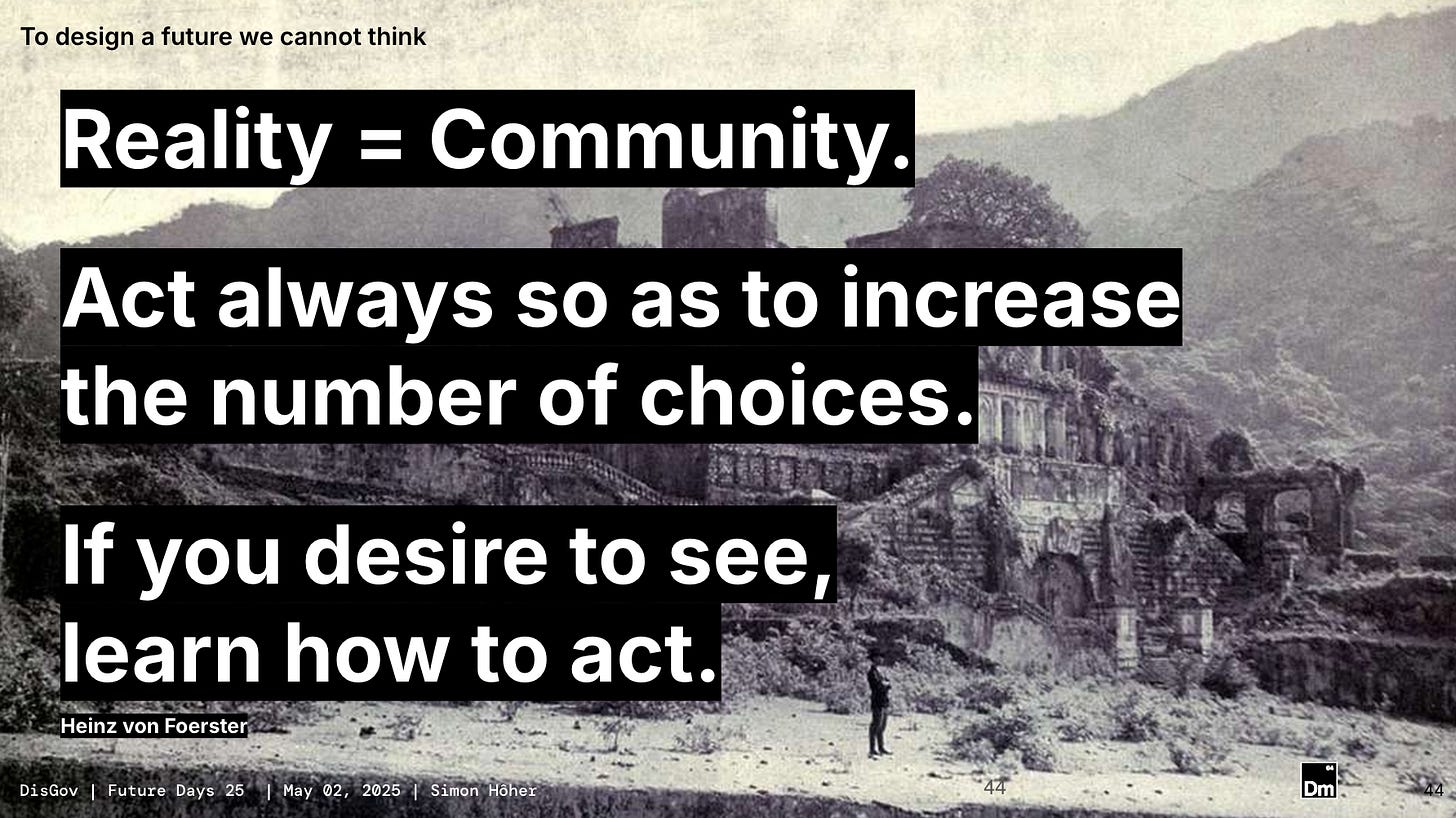Governing Unthinkable Futures (Talk)
Video and recap from my talk at FutureDays Lisbon, May 2025
A few months ago, I wrote about how unthinkable futures emerge from the failure of our imagination, rather than from its expansion. At FutureDays in Lisbon, I had the chance to take this into more practical territory: If we can't think our way to radical futures, how do we actually work with them?
FutureDays is a beautifully curated gathering of futures practitioners, artists, and researchers in what might have been the most inspiring venue I've experienced for a conference. I shared a few notes and questions from my work at Dark Matter Labs and NetZeroCities, along with examples and observations from my own research
My talk has recently been published and you can watch it here:
Beyond the Frame
The core insight remains: the most transformative changes – from Haiti's revolution to today's climate breakdown – exceed our frameworks even as they unfold. But there's a crucial shift from diagnosis to practice. Instead of trying to think beyond our own frameworks, we need to work with, within and in-between them.
The question isn't whether we can imagine our way out of our current crises, but how we can lay the enabling conditions for worlds to emerge that, in the present, exceed our current capacity to think them. And it’s about how to hold space for glitches, that sit in between signal and noise, as nuisances, holding options yet to be unpacked.
Five Practical Lenses
I shared five lenses to do so, drawing specifically on our ongoing work around distributed governance at Dm (more on that soon).
1. Sensing the Invisible
Making legible what sits outside institutional frames
Systems are able to observe certain things and ignore others – that is their entire point. But for our institutions dealing with governing collective transitions that becomes a challenge: Trees become cost factors rather than complex ecological assets. Economic indicators dominate while measures of actual wellbeing remain invisible.
How can we make visible the many worlds of the present that are essential for our collective survival, yet evade the logics of our institutions?
In practice this means to build better metrics aim to rebuild the sensing layer of our institutions. From TreesAI, making visible the health and climate benefits of urban trees to Cornerstone Indicators measuring things like "8-year-old girls who bike to school every morning" as a proxy for neighborhood safety and equality.
2. Hosting Benevolent Parasites
Creating infrastructures for emergence
Following Michel Serres' notion of the parasite,1 we have to re-discover the irritating presences that don't fit our categories but disrupt systems in potentially generative ways. Instead of eliminating them, we need to create conditions where they can thrive.
In practice vehicles like the Prototype Fund provide resources for open-source public interest tech without prescribing outcomes. Cultural places like Chimurenga in Cape Town or Kiosk Radio in Brussel imagine different versions of the city through arts, music and culture. In a similar vein Muslim Futures aims to create spaces empowering and disruptive space together with futurists from the fields of art, culture, and political educationThese create enabling conditions for what we can't yet name.
3. Coordinating Autonomous Actions
Working with binaries without being trapped by them
Real transformation requires moving beyond either/or thinking while acknowledging that binaries are necessary for orientation. I wrote about this earlier: The key is creating coordination mechanisms that don't require central control, but embrace / enable distributed self-governance.
In practice missions like NetZeroCities aim to help 100 European cities coordinate toward shared climate goals while maintaining local autonomy. Decentralised dashboards in cities like Eindhoven and Helmond’s climate dashboard enable actors to self-coordinate without master planning.
4. Designing for Emergence
Enabling conditions over end-states
Moving beyond “silver bullet” solutions toward understanding system interdependencies. Instead of delivering predetermined outcomes, we change conditions and let systems respond.
In practice: This is closely connected to working with systemic portfolios, a practice that has been emerging in the UNDP and elsewhere recently. Trondheim's walking strategy – placing benches throughout the city naturally encourages walking. Simple interventions in system conditions rather than forcing behaviours. The focus shifts from making plans to creating and re-shaping conditions and options spaces.
5. Learning to Learn Systemically
Building collective capacity for uncertainty
This requires balancing variation (the new) with retention (the stable) without falling into chaos or death spirals. It's about developing selection functions—cultural processes that help us discern when to embrace the new and when to retain the old.
In practice, Truth and Reconciliation Commissions transcend justice/truth binaries to create healing pathways. Europe Talks matches political opponents in structured conversations. These are deliberate interventions into systemic learning loops.
An Ethical Imperative
Through all this, what emerged from translating theory into practice can be captured beautifully with Heinz von Foerster:
It's not about “solving” the problem of limited imagination but about making it productive.
Michel Serres, The Parasite (1982).





![Screen Recording 2025-07-09 at 14.03.32.mov [video-to-gif output image] Screen Recording 2025-07-09 at 14.03.32.mov [video-to-gif output image]](https://substackcdn.com/image/fetch/$s_!YqT0!,w_1456,c_limit,f_auto,q_auto:good,fl_lossy/https%3A%2F%2Fsubstack-post-media.s3.amazonaws.com%2Fpublic%2Fimages%2Fb1e9985d-9160-4e76-ae21-8b208e52a69a_800x449.gif)
![Screen Recording 2025-07-09 at 14.02.54.mov [video-to-gif output image] Screen Recording 2025-07-09 at 14.02.54.mov [video-to-gif output image]](https://substackcdn.com/image/fetch/$s_!b2dC!,w_1456,c_limit,f_auto,q_auto:good,fl_lossy/https%3A%2F%2Fsubstack-post-media.s3.amazonaws.com%2Fpublic%2Fimages%2F5d4cc592-c4e7-49b4-bee1-0bfd0f9de352_800x449.gif)
![Screen Recording 2025-07-09 at 14.01.55.mov [video-to-gif output image] Screen Recording 2025-07-09 at 14.01.55.mov [video-to-gif output image]](https://substackcdn.com/image/fetch/$s_!GZ3M!,w_1456,c_limit,f_auto,q_auto:good,fl_lossy/https%3A%2F%2Fsubstack-post-media.s3.amazonaws.com%2Fpublic%2Fimages%2F69405264-5ce0-4602-9fb6-87ef3ac08cc1_800x449.gif)
![Screen Recording 2025-07-09 at 14.01.37.mov [video-to-gif output image] Screen Recording 2025-07-09 at 14.01.37.mov [video-to-gif output image]](https://substackcdn.com/image/fetch/$s_!-Zll!,w_1456,c_limit,f_auto,q_auto:good,fl_lossy/https%3A%2F%2Fsubstack-post-media.s3.amazonaws.com%2Fpublic%2Fimages%2Ff38f94f2-96af-4109-b313-74d786c2e558_800x449.gif)
![Screen Recording 2025-07-09 at 13.58.12.mov [video-to-gif output image] Screen Recording 2025-07-09 at 13.58.12.mov [video-to-gif output image]](https://substackcdn.com/image/fetch/$s_!Sx-R!,w_1456,c_limit,f_auto,q_auto:good,fl_lossy/https%3A%2F%2Fsubstack-post-media.s3.amazonaws.com%2Fpublic%2Fimages%2F943a495c-ca96-49dc-9723-030a847e3cbd_800x449.gif)
![Screen Recording 2025-07-09 at 14.00.55.mov [video-to-gif output image] Screen Recording 2025-07-09 at 14.00.55.mov [video-to-gif output image]](https://substackcdn.com/image/fetch/$s_!_95f!,w_1456,c_limit,f_auto,q_auto:good,fl_lossy/https%3A%2F%2Fsubstack-post-media.s3.amazonaws.com%2Fpublic%2Fimages%2F35f69e60-f8c2-41de-a1de-252f83e8cc4d_800x449.gif)

"Act always so as to increase the number of choices" is so much about building optionality among the adjacent possible.